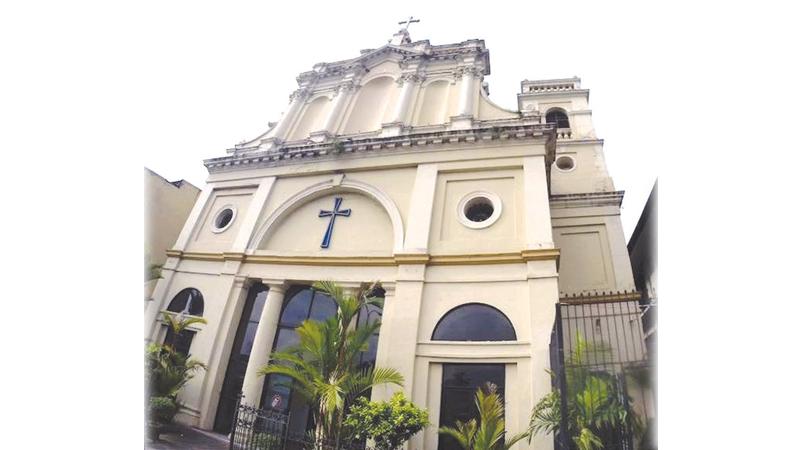
The area around the Fort Railway Station is probably the busiest hub in Colombo. It is the location where thousands of train commuters enter the city, along with others who come by bus. The traffic buildup is often intense. Amid all the confusing noises of the city, Christian worshippers can still find solace in a shrine built over 150 years ago.
 The church dedicated to St. Philip Neri stands, somewhat shrouded by other buildings. Yet, her magnificent Corinthian front, replicates the Church of St. John Lateran in Rome. Decades ago the church was one of two iconic landmarks in the Pettah, the other being the Fort Railway Station. It was an era when horse drawn carts trotted on cobbled streets. For five decades this church has been the home of the priests attached to the Blessed Sacrament Congregation which was established in France.
The church dedicated to St. Philip Neri stands, somewhat shrouded by other buildings. Yet, her magnificent Corinthian front, replicates the Church of St. John Lateran in Rome. Decades ago the church was one of two iconic landmarks in the Pettah, the other being the Fort Railway Station. It was an era when horse drawn carts trotted on cobbled streets. For five decades this church has been the home of the priests attached to the Blessed Sacrament Congregation which was established in France.
Birth of a new church
One of the first zealous missionaries who came to Ceylon was Joseph Vaz, who landed in Jaffna in 1687. He was a member of the Oratorian Order, founded in 1578 by the prudent priest Fr. Philip Neri in Italy. Since then the flames of faith were ignited and sustained during the rule of the Dutch in Ceylon. Subsequently, the Catholic Vicar Apostolic of Colombo, Rt. Rev. Joseph Bravi came to Colombo and lived in the small chapel in the Pettah. The chapel, 60 feet in length and 30 feet in width was rather dim and gloomy. The parish at that time consisted of British soldiers and Dutch burghers.
The Vicar was convinced that he would transform this same venue into a vibrant community of worship. In 1858 he managed to obtain 1,000 sterling pounds from the state and another 1,500 sterling pounds from the faithful Catholics. He laid the foundation stone for the new church. When a name was required he remembered the pioneering work of the Oratorian fathers and dedicated the church to Saint Philip Neri. The new church could accommodate 600 people and was one of the largest churches of that era.
The final building cost amounted to 4,000 sterling pounds. The church was blessed by the Vicar General in February 1862.
The church bell, weighing 2,056 lbs was cast in Negombo and rung for the first time in July 1894. Rt. Rev. Joseph Bravi, who served this church with great dedication passed away and was interred here.
As I walked into this sanctuary the sunlight drifted inside to gently light up the brown and white interior. A few nuns were at prayer in the Michael’s wing on the left.
Since 1956 this church has been under the custody of the SSS community. They were invited by Cardinal Thomas Cooray and came to Colombo from Australia. The founder of the SSS (Blessed Sacrament Congregation) is Saint Peter Julian Eymard. As a young man Julian Eymard was deeply moved by the Holy Eucharist and pleaded with the Archbishop of France to commence a new order. The new order was established in 1856- and exactly 100 years later in 1956, the first spiritual delegation of 3 priests and 2 Brothers arrived in Colombo to discharge their liturgical and sacramental ministry. These pioneer clergymen were Fr. Henry Polini, Fr. James Poyard, Fr. Patrick Fitzgerald, Bro. Kevin Gallagher and Bro. Stephen Mc Kenna. This mission to Ceylon was the first in Asia undertaken by the SSS community.
Influence of the Bharatha community
During the early days of the mission the church attracted members of the Bharatha community, who were engaged in business in the Pettah. The Bharatha community can trace its roots to South India. Their patron saint is the Lady of Snows. Senior members of the parish recollected that when the statue of the Lady of Snows paraded the streets devotees would place rose petals. The Ceylon Police Band had also rendered some hymns. The history of this veneration dates back to the 17th century in Tuticorin, where the ‘Panimaya Matha’- Lady of Snow was adapted by the pious Bharatha community, which practice they brought to Ceylon when they came as traders. Likewise, the traders of Malayalam origin worshipped at St. Anthony’s Church, Kochikade. Decades ago the Shrine of Philip Neri served the Catholic seamen who called in at the Port of Colombo, as the church was close to the harbour. During this time the church of St. Peter attended to the needs of the Anglican seafarers.
Today, the main altar has a figure of Christ, suspended amid a somewhat unusual design of many wooden rods, which I was made to understand depicted roads. All the paths finally lead upwards, to heaven. The sanctuary has many other religious statues. The faithful priests of the Blessed Sacrament community continue their good work. For more than 150 years this church has served the Christian office workers in Fort and also other devotees.
